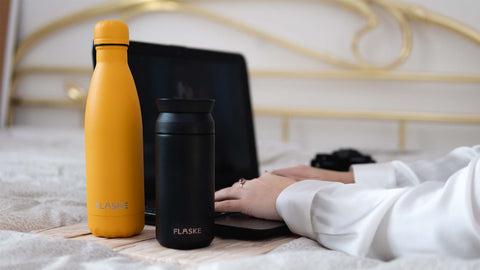For anyone asking the question ‘how to be more sustainable’, we’ve got some practical tips for you.
Becoming more sustainable and living a more sustainable lifestyle may seem like a difficult task. You might be imagining your life without takeaway coffees and fast food or adding up the price of shopping for organic produce.
Fortunately, becoming more sustainable can be simpler than you think. You don’t need to make changes to every part of your daily routine at the same time. That said, some small lifestyle changes will go a long way.
With that in mind, we’ve put together a selection of easy to adopt habits that will make a surprisingly large impact on your carbon footprint.
How to Be More Sustainable: 5 Simple Habits
Below, we’ve outlined five simple habits that will help you live more sustainably in your daily life. It’s also useful to understand what sustainability means and why it’s important.
If you’d like some more tips on how to live more sustainably, check out the FLASKE Blog. You’ll find lots of advice on how to be more sustainable at home, on the go, and at the office.
Use a Reusable Water Bottle
Ditching plastic is one of the best things you can do to be more sustainable in your daily life.
Disposable water bottles are one of our pet hates. Not only are they a waste of non-renewable resources and a waste of your hard-earned money. But single-use plastic bottles are also bad for health and toxic to the planet.
Instead, buy a BPA-free reusable water bottle and take it everywhere you go. There are many places around cities where you can refill a water bottle throughout the day, so you won’t need to buy a disposable bottle again.

Save your leftovers
Food waste is another common problem, particularly in western societies. Two of the easiest ways to reduce food waste are to store your foods correctly and stop throwing out leftovers. Instead, store any leftover foods from dinner in an airtight container so that you can enjoy them the next day.
If you want to be more sustainable and inspire others to do the same, you could even take your leftovers for lunch on workdays or send your kids to school with an insulated lunch box.

Additionally, you can try buying food when you need it rather than making one big shop each week. That way, your fruits and vegetables won’t go mouldy before you get to enjoy them. Also, you can find out where your local food bank is and how to donate to them. Or, consider composting in your garden or use a worm bin if you live in an apartment.
Walk & Cycle More
Greenhouse gas emissions from cars and other road vehicles are one of the biggest contributors to climate change. What’s more, air pollution is a major problem in urban areas and areas close to major roads.
Therefore, the most obvious way to be more sustainable is to avoid driving as much as you can. You may not be able to give up your car completely, but you can try walking or cycling anywhere within five to ten miles. And take public transport instead of driving a private car whenever possible.
Bring Your Own Coffee Cup
Take away cups and food containers were among the top ten most littered items in the Ocean Conservatory’s 2019 International Ocean Cleanup. That’s shocking when you consider how easy it is to bring your own reusable coffee mug when you want a coffee to go.
Getting into the habit of taking an insulated coffee cup for your morning commute isn’t just good for the planet. It’s also good for your wallet. You can save money by making your favourite beverage at home. Additionally, some cafes’ offer discounts to customers that bring their own travel coffee mug.
If you don’t already have an insulated travel coffee mug, you can order one today with your name on it!

Eat Mindfully
To know how to live more sustainably, one of the most important things you need to learn is that the food you eat has a big impact on your carbon footprint.
The energy and resources, such as land and water, used to produce, package, and transport foods means that everything you eat has a hidden carbon footprint. Therefore, to live more sustainably, you’re going to need to look a little more carefully at how and where your food was produced. But you can also consider what goes on your plate.
Let’s use vegetables grown in greenhouses as an example. These require water and nutrients, just like any other vegetables. But they also need extra energy to regulate temperatures inside the greenhouse. Similarly, imported products must be packaged, often in single-use plastic containers, and transported by road, ship, or plane. All of which will require fossil fuels.
Simple habits, such as checking food labels, buying locally, eating seasonal vegetables, eating less meat, and avoiding foods in plastic packaging, will help you live more sustainably.
How to be Sustainable
Living more sustainably is something that we should all try to do. Although it’s not an overnight process, most people can easily become more sustainable by adopting a few simple habits. Ditching disposable plastics, reducing food waste, and choosing your foods carefully will make a surprisingly big impact!
For more tips on how to live more sustainably, subscribe to the FLASKE Blog or visit the FLASKE Collection to view our range of eco-friendly products.

